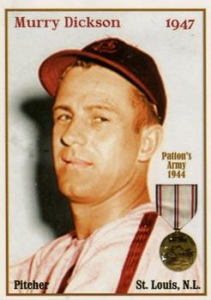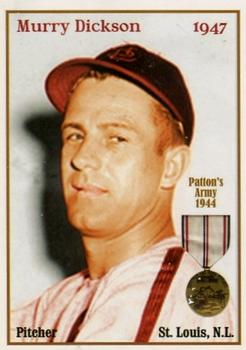October 3, 1946: Cardinals finish tiebreaker sweep, advance to the World Series
 In 1946, for the first time in history, a major-league pennant race ended in a tie when the Brooklyn Dodgers and St. Louis Cardinals ended the 154-game season with identical 96-58 records. National League rules specified a best-of-three playoff; the winner of a coin toss could choose to either open the series at home, which would mean playing Games Two and (if needed) Three on the road, or opt for Game One on the road with home-field advantage if the series went the three-game limit.
In 1946, for the first time in history, a major-league pennant race ended in a tie when the Brooklyn Dodgers and St. Louis Cardinals ended the 154-game season with identical 96-58 records. National League rules specified a best-of-three playoff; the winner of a coin toss could choose to either open the series at home, which would mean playing Games Two and (if needed) Three on the road, or opt for Game One on the road with home-field advantage if the series went the three-game limit.
Given the right to call the toss, Cardinals owner Sam Breadon picked heads, but it came up tails; Dodgers manager Leo Durocher elected to open the series in St. Louis. “The Lip,” wrote Robert Weintraub, “wanted to have the deciding game played at home, so he agreed to head to Missouri for the opener, then host Games Two and Three, should a third game be necessary.”1
It was perhaps fitting that the regular season had ended in a deadlock between Brooklyn and St. Louis, as there were many “family ties” between the teams. Dodgers President and general manager Branch Rickey had held the same position with the Cardinals from 1917 to 1942, and Durocher had played for the Redbirds from 1933 to 1937. Much of the St. Louis roster consisted of players signed during Rickey’s Cardinal tenure; St. Louis manager Eddie Dyer had begun his major-league playing career when Rickey managed the club, and then got his start as a manager in Rickey’s Cardinal farm system. There was even a pair of brothers opposing each other in the playoff series: Dixie Walker for the Dodgers, Harry Walker for the Cardinals.
The series opened at St. Louis’s Sportsman’s Park on Tuesday, October 1, with Howie Pollet (20-10) of the Cardinals facing Ralph Branca (3-0) of the Dodgers. The game was tight, but Pollet threw a complete-game eight-hitter for a 4-2 Cardinals victory while battling a shoulder injury and an oblique strain. Veteran center fielder Terry Moore and rookie catcher Joe Garagiola each had three hits for St. Louis.
After a day off for travel – the train trip from St. Louis to New York City took over 20 hours – the series resumed at Brooklyn’s Ebbets Field on Thursday, October 3. Dodgers rookie left-hander Joe Hatten (14-10) took the hill against the Cardinals’ Murry Dickson (14-6) before a packed house of 31,437. The Brooklyn Eagle reported that at 9:30 A.M., over 10,000 fans were lined up to buy tickets, and that the queue had grown to twice that number by noon. “Many of the fans,” the paper reported, “had been waiting in line since midnight.”2 Scalpers were charging $25 for tickets with a face value of $1.75.
“If [Eddie Dyer] leads with Murry Dickson, a righthander,” Durocher had stated in his ghost-written “Durocher Says” column the morning of the game, “we will stack our lineup with lefthanded power, playing [Augie] Galan at third and [Dick] Whitman in the outfield. We figure to get a hatful of runs in our own ballyard. Dickson should be no puzzle.”3 His assessment appeared to be correct when Dodgers left-handed hitters broke through against Dickson in the bottom of the first (after Hatten had set down the Cardinals in top half). With two out Galan reached first on an infield hit, lefty swinger Dixie Walker drew a walk, and another left-handed hitter, Ed Stevens, drove in Galan with a single to center. But Dickson retired Carl Furillo to end the threat and then took command, not permitting another Dodgers hit until the bottom of the ninth. Fred Lieb wrote that “in the intervening seven innings, [the Dodgers] were as helpless before Murry Dickson, little St. Louis righthander, as so many Erasmus High School boys.”4 Over that seven-inning span, Dickson allowed only one ball past the infield. “Dickson was using his knuckler and had great control on his curve, and his fastball was sinking in,” Dyer commented after the game. “That was why those Dodgers were hitting into the dirt around second base.”5
The Cardinals wiped out Brooklyn’s 1-0 lead in the top of the second. With one out Erv Dusak tripled to left; the Dodgers protested that Galan had tagged Dusak before his foot touched third, but third-base umpire Beans Reardon stood by his call. (Photos in the next morning’s Brooklyn Eagle indicated that Dusak should have been called out.) Marty Marion, the next hitter, drove in Dusak with a fly ball to center field. Clyde Kluttz then singled to center, and Dickson gave himself the lead with a triple to center field. It was the first triple of Dickson’s major-league career, which had begun in 1939.
It was still 2-1 in the top of the fifth when the Cardinals put together another rally. After Stan Musial doubled with two out, Durocher elected to intentionally walk right-handed-hitting Whitey Kurowski to set up a lefty-lefty matchup between Hatten and Enos Slaughter. Slaughter spoiled the strategy with the Cardinals’ third triple of the game, scoring Musial and Kurowski. Dusak then singled to plate Slaughter with the Cardinals’ third run of the inning. St. Louis scored another run in the seventh on two walks, a sacrifice, and a beautiful squeeze bunt by Marion, and twice more in the eighth when Kurowski singled with the bases loaded.
With an 8-1 lead entering the bottom of the ninth and Dickson looking invincible, the Cardinals were preparing to sip the champagne. But the Dodgers weren’t quite ready to surrender. Galan opened the frame with a double off the right-field wall (“the first Brooklyn hit in roughly two and a half hours,” wrote Robert Weintraub6), and scored one out later when Stevens tripled. Furillo singled to score Stevens, and when Dickson threw a wild pitch to move up Furillo and then walked Pee Wee Reese, Dyer replaced Dickson with left-hander Harry Brecheen. The first batter he faced, Bruce Edwards, singled to drive in Furillo, and suddenly it was 8-4. When pinch-hitter Cookie Lavagetto drew a walk, the bases were loaded with the tying run coming to the plate, and still only one out.
Brecheen retired Eddie Stanky on a called third strike for the second out, and 6-foot-6 Howie Schultz, who had homered in the first game of the tiebreaker series, advanced to the plate as a pinch-hitter. Dyer came to the mound and told Brecheen, “Forget about the home run. Just get the ball in there.” Brecheen took Dyer’s advice, and, wrote Weintraub, “Schultz whacked it down the left-field line. It landed in a cloud of dirt … just foul. An inch to the right, and three runs would have scored.” With the count 3-and-2, Brecheen surprised Schultz by throwing a screwball. “I almost fell down swinging at it,” Schultz, known as “The Leaning Tower of Flatbush,” said later. He missed it by nearly a foot, and the Cardinals were heading to the World Series to face the Boston Red Sox.7
“In my opinion this is the last time the St. Louis ball club will be that close to us,” proclaimed Durocher the next day. “I told our boys yesterday they have some big years ahead of them. We will all be riding high with the players already here plus the sensational kids Branch Rickey has been getting ready at Montreal, Fort Worth and Mobile.”8 Durocher proved to be an accurate prophet: Over the next 10 seasons, the Dodgers would win six National League pennants, the Cardinals none … thanks in good part to a group of “sensational kids” led by Jackie Robinson, who would arrive in Brooklyn the next year.
SOURCES
In addition to the sources cited in the Notes, the author consulted Baseball-Reference.com, Retrosheet.org, and the following:
Drebinger, John. “Cards Win Pennant, Defeating Dodgers Again for Two-Game Play-Off Sweep,” New York Times, October 4, 1946: 17.
“He Done Us Wrong” (photos with caption), Brooklyn Daily Eagle, October 4, 1946: 15.
Photo credit: Murry Dickson, Trading Card Database.
NOTES
1 Robert Weintraub, The Victory Season: The End of World War II and the Birth of Baseball’s Golden Age (New York: Little, Brown and Company, 2013), 308.
2 “Ebbets Field Stormed by 20,000 Rabid Fans,” Brooklyn Daily Eagle, October 3, 1946: 1.
3 “Durocher Says: We’re Set to Trump ‘Em On Our Own Field Today,” Brooklyn Daily Eagle, October 3, 1946: 16.
4 Fred Lieb, “Cards Hold Mastery Over Dodgers to End,” The Sporting News, October 9, 1946: 8.
5 Sid Feder, “Cards’ Celebration Like A-Bomb Bursting,” St. Louis Globe-Democrat, October 4, 1946: 19.
6 Weintraub, 315.
7 Weintraub, 315.
8 “Durocher Says: We’d Have Given Sox Better Fight Than Cards,” Brooklyn Daily Eagle, October 4, 1946: 15.
Additional Stats
St. Louis Cardinals 8
Brooklyn Dodgers 4
Game 2, NL tiebreaker
Ebbets Field
Brooklyn, NY
Box Score + PBP:
Corrections? Additions?
If you can help us improve this game story, contact us.


